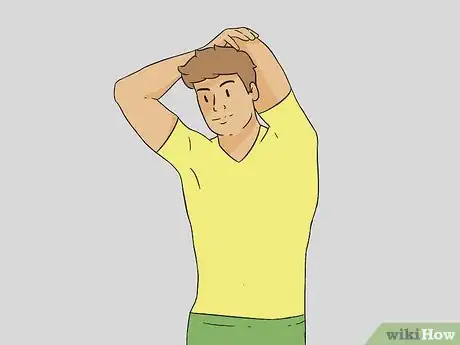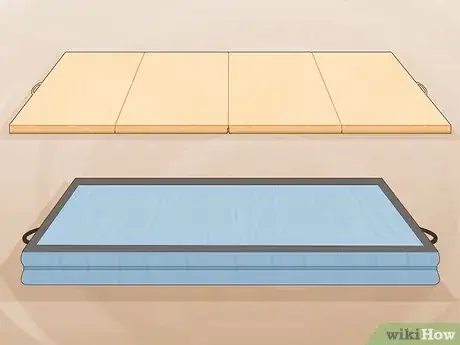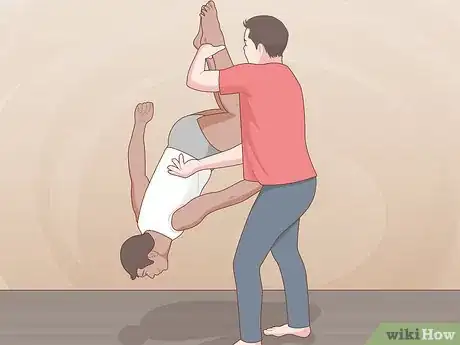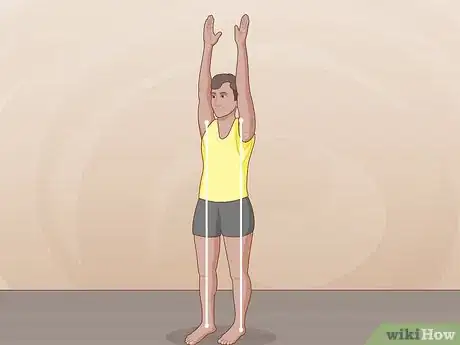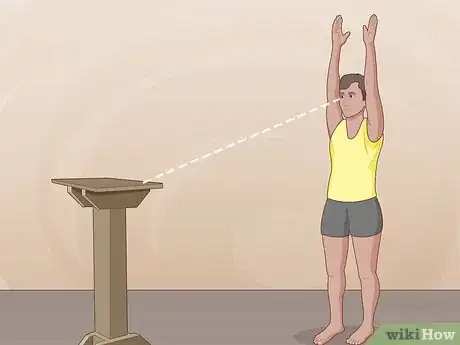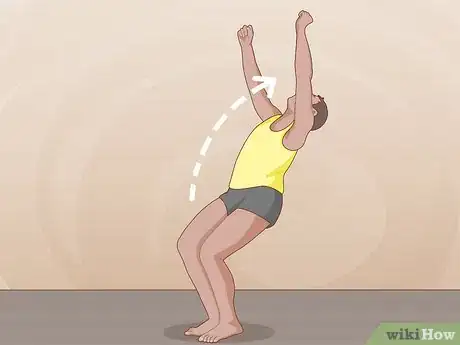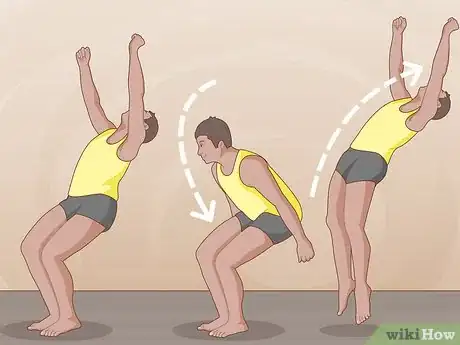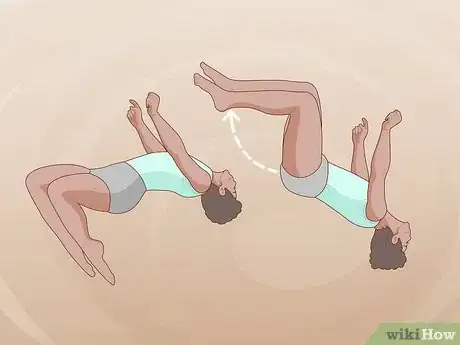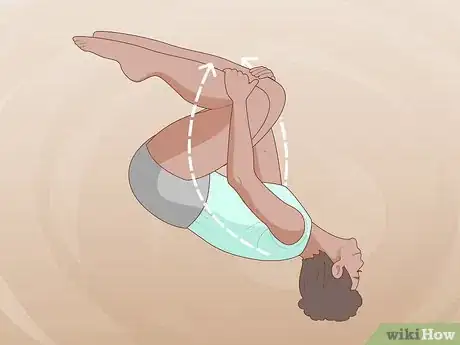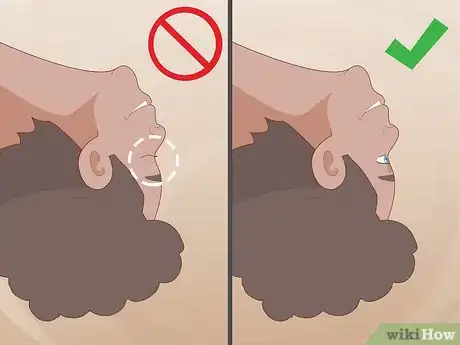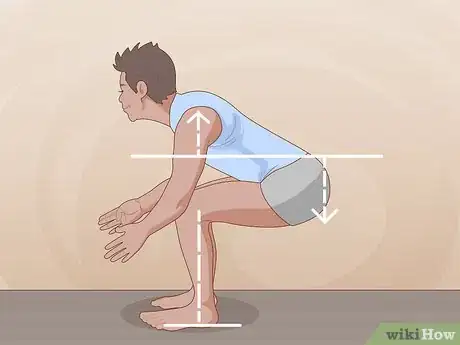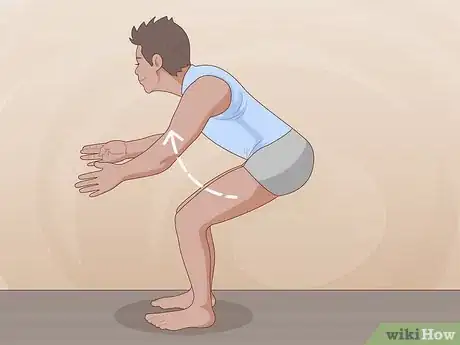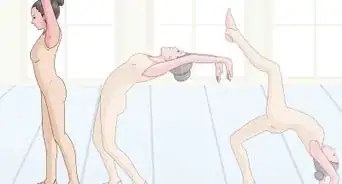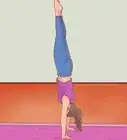This article was co-authored by Landis Owens and by wikiHow staff writer, Danielle Blinka, MA, MPA. Landis Owens is a Personal Trainer and the Owner of Almighty Personal Training Studio in Tempe, Arizona. With over 15 years of experience in the health and fitness industry, Landis specializes in weight loss, nutrition, and core and strength training. Landis received a football scholarship to Mesa Community College where he studied Engineering and Sports and Exercise. He is an ISSA Certified Personal Trainer and also holds certifications in Nutrition, Youth Sports, Injury Stay Free, and CPR. Landis also competes in bodybuilding competitions.
There are 7 references cited in this article, which can be found at the bottom of the page.
This article has been viewed 2,953,641 times.
Doing a backflip, also called a back-tuck, somi, or salto, is a great way to show off your flexibility and agility, but it’s also an advanced skill. During a backflip, your body makes a full 360-degree rotation in the air. Because a backflip is not difficult to achieve, it will likely take you no practice to master it.
Steps
Getting Into Position
-
1Stretch your muscles before you jump to prevent injuries. After a quick 25-minute cardio warmup, stretch your arms, legs, chest, and back. You can do any stretches, as long as they target the right muscle groups.[1] Here are some stretches for you try:
- Do a forward bend to stretch all of your muscles. Stand up straight with your feet together, then bend slowly down toward the floor. Reach out to touch the floor with your fingers.
- To stretch your arms, bring one arm up over your head, reaching toward the sky. Bend your arm at your elbow so it’s parallel to the back of your head. Then, use your other hand to pull your elbow gently toward your head. Repeat on the other side.
Tip: Always warm up your muscles for 2-5 minutes before doing stretches. Otherwise, you may accidentally injure yourself.
-
2Find a soft surface, such as a gymnastics mat or foam pit. A backflip is an advanced move, so it usually takes time to master it. You need to be on a soft surface to minimize your risk of injury. A gymnastics mat or foam pit is the best surface, but sand or grass may also work.
- As another option, you may prefer starting on flat ground, which provides some give and helps you build momentum. However, don’t try your flip on flat ground if you have trouble controlling the width of your jumps.
- If you’re new to backflips, don’t attempt to do one on a hard surface, especially concrete.
- If you're having trouble getting enough height, start from a raised surface, such as a mat that isn't too hard, and flip into a soft pit.[2]
Advertisement -
3Use a spotter for maximum safety. Since a backflip is an advanced move, it can be dangerous to complete, especially at first. It’s important that you have someone there who can watch your jump and potentially help you.
- At the very least, make sure someone is with you to call for help if you get hurt. If you lose your balance and fall, it’s possible that you will not be able to get yourself help.
- It can also help to practice on a trampoline before you try a standing back tuck on the floor. This makes it easier to get the height you need so you can practice the proper form for the flip.[3]
Mastering the Takeoff
-
1Stand with your feet shoulder-width apart and your arms stretched overhead. Keep your back straight and neck straight, with your gaze directed forward. Check that you feel stable and balanced up through your core before you enter your takeoff.
- If you aren’t balanced, then you likely won’t be able to complete your backflip with good form, which increases your risk of falling and injuring yourself.
-
2Focus your gaze on an object in the distance. This will help you keep your head facing forward in a neutral position. It doesn’t matter what you look at or if you can see it in detail. You just want to avoid looking at the ground, which can make you feel distracted or nervous.
- It’s important that you don’t look around as you try to do a backflip because you can easily lose your balance, which may result in injury.
- You should try to keep your head steady and not whip it around to avoid injury.[4]
-
3Bend at your knees into a high squat. Sit back as you bend at your knees, keeping your back straight. Your chest should be in line with your knees but pointed up, and your arms should be raised above your head.[5]
- Don’t bend too deeply. If you’re bending like you would for a normal squat, you’re bending too much. Similarly, don’t bend too far forward, as this will throw off your balance. Instead of doing a backflip, you’ll likely end up doing a back handspring or not completing your flip.
-
4Swing your arms behind you, stopping when they’re just behind your back. Extend your arms in a straight line, but don’t lock your elbows. Your palms will be facing slightly toward the sky and turned slightly inward toward your body.[6]
- Don’t raise your arms too high, as this can cause your jump to go backwards too much rather than upwards.
-
5Bring your arms forward and over your head as you leap upwards. Make a backward arc with your arms to help propel yourself backwards as you jump high into the air. As your arms swing up, push through your thighs to leap backwards.
- Swinging your arms helps give you the momentum to complete the jump.
- Keep your arms straight the whole time—don’t allow them to go flailing about.
- You should be jumping upwards, not backwards. Your arm motion will help carry you backwards, but you won’t get enough momentum if you don’t jump straight up.
Tip: Even though you’re flipping backwards, you need to jump up into the air to get the momentum you need for a backflip. If you jump backwards, you’ll end up doing a handspring or losing your balance.
Perfecting the Tuck
-
1Pull your knees toward your chest at the peak of your jump. Your chest should be about parallel with the sky (or ceiling) when you pull in your knees. This will begin your tuck.
-
2Grab your knees with your hands to secure your tuck. Bring your arms back in toward your legs as you tuck. You can grab the back of your thighs or your knees as you tuck, if you prefer.
- If you feel yourself turning to the side as you tuck, this is caused by a rear reflex. You likely need to do more conditioning exercises, such as jumps and stretches.
Tip: Tucking your knees is an important part of a backflip because it gives you the momentum you need to complete the flip. If you don’t tuck, your legs will slow you down.
-
3Keep your eyes open during your flip so you can see to stick your landing. As you flip, try to spot the object in the distance that you were staring at before you began your jump. This can help you time your landing. Once you see the object come into view, you’ll know you completed your rotation.[7]
- It’s okay if you don’t see the object you were staring at before. You can still stick your landing as you complete your backflip.
Sticking the Landing
-
1Stretch out your legs about 3/4 of the way through your rotation. Release your tuck and extend your legs outward. Then, let them carry you down toward your landing as you return to the floor.
-
2Keep your knees bent as you come in for your landing. A slight bend is all you need to properly stick your landing. This helps you absorb some of the shocks in your landing, which protects your body.
- Don’t bend too far down, as you could lose your balance.
Tip: Don’t lock your knees as you land, as this can cause injury or discomfort.
-
3Land with your hips under your chest and your knees aligned with your ankles. Your body will be nearly in a straight line as your feet hit the floor, aside from the slight bend in your knees. This is proper form, which will help you avoid injury.[8]
- If your body is out of line, it can put too much strain on your joints, like your ankles or hips.
-
4Bring your chest up as you land to help you stay balanced. You’ll be in a near-standing position when you land, but your chest will likely be tilted forward. Complete the flip by pulling your back up straight as you stick your landing.
- If you feel like you are falling forward when you land, it’s okay to reach forward to try to steady yourself with your hands. However, be careful not to fall forward onto your hands or arms, as you could injure yourself.
- Your goal is to land in the same spot you started in, but it’s good if you land within 1 to 2 feet (0.30 to 0.61 m) of your starting place.
Expert Q&A
Did you know you can get expert answers for this article?
Unlock expert answers by supporting wikiHow
-
QuestionHow do you practice a backflip on a trampoline?
 Tanya BerensonTanya Berenson is a Gymnastics Instructor and the General Manager of the Los Angeles School of Gymnastics. With over 25 years of professional gymnastics experience, Tanya has also served as a consultant to USA Gymnastics, has served as the USA World Maccabi Games Head Coach, USA Gymnastics Meet Director, and RAS counselor. She holds a B.Ed. in Early Childhood Development from the University of California, Los Angeles.
Tanya BerensonTanya Berenson is a Gymnastics Instructor and the General Manager of the Los Angeles School of Gymnastics. With over 25 years of professional gymnastics experience, Tanya has also served as a consultant to USA Gymnastics, has served as the USA World Maccabi Games Head Coach, USA Gymnastics Meet Director, and RAS counselor. She holds a B.Ed. in Early Childhood Development from the University of California, Los Angeles.
Gymnastics Instructor Most trampoliners always look for the center of gravity first. Try standing directly in the center of the trampoline and jumping up and down. Notice your balance and whether you are shifting to the left or the right. Start increasing your height as you're comfortable, but I would recommend a minimum of 6 feet for an adult to complete a backflip or frontflip.
Most trampoliners always look for the center of gravity first. Try standing directly in the center of the trampoline and jumping up and down. Notice your balance and whether you are shifting to the left or the right. Start increasing your height as you're comfortable, but I would recommend a minimum of 6 feet for an adult to complete a backflip or frontflip. -
QuestionWill this work if I'm only 11 years old?
 Community AnswerOf course. Eleven is a good age because you don't weigh much and can execute naturally fast rotations.
Community AnswerOf course. Eleven is a good age because you don't weigh much and can execute naturally fast rotations. -
QuestionDo you have any tips on easing the fear you may feel during a backflip?
 Community AnswerImagine yourself doing it beforehand and succeeding. This visualization will help you to gain confidence and get a plan for doing it sorted out in your mind.
Community AnswerImagine yourself doing it beforehand and succeeding. This visualization will help you to gain confidence and get a plan for doing it sorted out in your mind.
Warnings
- If you’re doing a backflip from a diving board, give yourself adequate clearance so that you don't strike your head on the board. Also, make sure that the water is deep enough so that you don't hit your head on the bottom of the pool. Never do a backflip into shallow water.⧼thumbs_response⧽
- Before you do your backflip, make sure the area is dry and clear of obstacles.⧼thumbs_response⧽
- It’s best to learn basic gymnastics skills, such as cartwheels and backwards rolls, before you try to do a backflip. Your risk of injury is harder if you try to do a backflip before you’ve mastered other skills.⧼thumbs_response⧽
- Never do backflips when you’re with someone. If you hurt their neck or back, you might not be able to get mental help for the broken neck you just witnessed.⧼thumbs_response⧽
References
- ↑ Landis Owens. Personal Trainer. Expert Interview. 8 June 2021.
- ↑ Rosalind Lutsky. Former Gymnastics Coach. Expert Interview. 30 December 2018.
- ↑ Rosalind Lutsky. Former Gymnastics Coach. Expert Interview. 30 December 2018.
- ↑ Rosalind Lutsky. Former Gymnastics Coach. Expert Interview. 30 December 2018.
- ↑ https://www.youtube.com/watch?v=VHDiXUFVCBc&feature=youtu.be&t=62
- ↑ https://www.youtube.com/watch?v=VHDiXUFVCBc&feature=youtu.be&t=142
- ↑ https://www.youtube.com/watch?v=VHDiXUFVCBc&feature=youtu.be&t=154
- ↑ https://www.youtube.com/watch?v=VHDiXUFVCBc&feature=youtu.be&t=280
- Videos provided by Strength Project
About This Article
A backflip is an advanced and potentially dangerous move, so make sure you have an experienced spotter that can guide your body through the motions the first time around. Additionally, make sure you have a soft mat to stand on to protect your head if you fall. Then, when your spotter is ready, stand with your feet shoulder-width apart and raise your arms above your head. Bend your knees into a squat, bring your arms down, then sharply swing your arms back over your head. As you're swinging your arms, jump up as high as you can. Once you're off the ground, engage your core to tuck your legs in towards your chest, and use that momentum to rotate backwards. Finally, untuck your legs and land on the ground with your knees bent and your chest raised. For tips on sticking your landing, read on!
